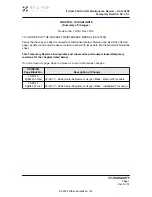
Setting Up the Sting 2 and Test-Flying
Section 4
25
Launch Check
The launch point check is carried out
immediately before launch to check once
again the most important safety points. It
should always be carried out in the same
sequence so that nothing is overlooked.
These points are:
1. Is the canopy arranged in a half-moon
shape and are all the air-entrances
open?
2. Are all the lines untangled and free of
knots or twists?
- are there any lines under the canopy?
- are any lines caught in the trimmer
clamp, risers or throttle?
- do all the lines run cleanly past the
cage?
3. Has the trimmer position been correctly
chosen?
4. Do you have the correct personal
equipment (motor unit, harness,
carabiners, reserve, helmet). Are the leg
straps done up?
5. Does the weather, in particular wind
direction and strength, allow a safe
flight?
6. Is the propeller clear?
7. Is the motor running properly?
8. Are the airspace and launch area clear?
Launch
Forwards launch
We recommend a forwards launch if there is
little wind. Pull up the glider with the lines
stretched. It is not necessary to use any
momentum to launch the Sting 2 and/or to
start running with slack lines.
While the glider is rising, guide the A-risers
evenly upwards in an arc, without shortening
them. Avoid pulling hard on the risers. The
Sting 2 launches very easily and is easy to
control. Launching is even easier if the
canopy is arranged in a half-moon shape.
Avoid moving your upper body sideways
when the glider is rising, as this could cause
lines to get caught in the propeller. If the
glider is not centred when it rises, correct it
using the risers rather than the brakes. This
will stop one side of the glider tipping away.
It is important during the take-off phase to
remain under the glider and to hold your
launch direction. When there is equal
tension on both risers and the glider is above
the pilot, check that the canopy is fully
inflated and that no lines are twisted or
caught up. Do not stand still when doing this,
but do not turn your upper body.
CAUTION
If the glider goes too far to the side or falls
down again, then stop the motor and
begin the launch procedure again.
After carrying out the visual inspection, use
full throttle. Leaning back slightly helps
launch, as the full engine power is used.
Release the risers and accelerate until the
Sting 2 takes off.
Take note of the following points during a
forwards launch:
if the cage for the motor is not firmly in
place, the risers can shift it during take-
off and press it against the propeller -
make sure this has not happened before
you fly at maximum power.
during launch, use of the brakes should
be smooth and moderate
lightly brake the Sting 2 when the canopy
reaches its apex
do not launch until the glider is above
you - accelerating too quickly can cause
dangerous pendulum motions
do not get into your harness until you are
a couple of meters in the air
Содержание Powerplay Sting 2
Страница 1: ...Version 1 0 Date 08 08 2014 Instruction Manual EN ...
Страница 55: ...Notes ...















































